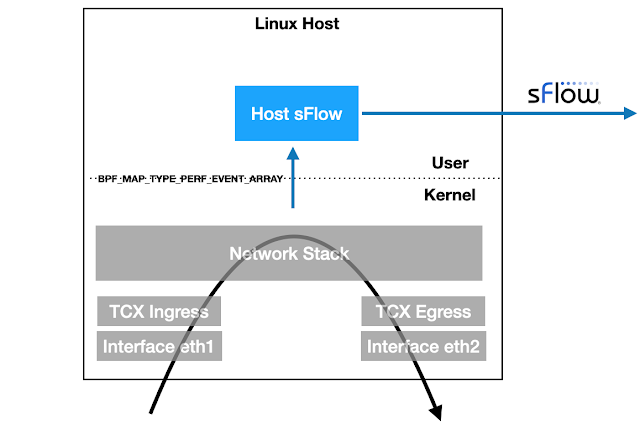Linux packet sampling using eBPF
Linux 6.11+ kernels provide TCX attachment points for eBPF programs to efficiently examine packets as they ingress and egress the host. The latest version of the open source Host sFlow agent includes support for TCX packet sampling to stream industry standard sFlow telemetry to a central collector for network wide visibility, e.g. Deploy real-time network dashboards using Docker compose describes how to quickly set up a Prometheus database and use Grafana to build network dashboards.
static __always_inline void sample_packet(struct __sk_buff *skb, __u8 direction) {
__u32 key = skb->ifindex;
__u32 *rate = bpf_map_lookup_elem(&sampling, &key);
if (!rate || (*rate > 0 && bpf_get_prandom_u32() % *rate != 0))
return;
struct packet_event_t pkt = {};
pkt.timestamp = bpf_ktime_get_ns();
pkt.ifindex = skb->ifindex;
pkt.sampling_rate = *rate;
pkt.ingress_ifindex = skb->ingress_ifindex;
pkt.routed_ifindex = direction ? 0 : get_route(skb);
pkt.pkt_len = skb->len;
pkt.direction = direction;
__u32 hdr_len = skb->len < MAX_PKT_HDR_LEN ? skb->len : MAX_PKT_HDR_LEN;
if (hdr_len > 0 && bpf_skb_load_bytes(skb, 0, pkt.hdr, hdr_len) < 0)
return;
bpf_perf_event_output(skb, &events, BPF_F_CURRENT_CPU, &pkt, sizeof(pkt));
}
SEC("tcx/ingress")
int tcx_ingress(struct __sk_buff *skb) {
sample_packet(skb, 0);
return TCX_NEXT;
}
SEC("tcx/egress")
int tcx_egress(struct __sk_buff *skb) {
sample_packet(skb, 1);
return TCX_NEXT;
}
The sample.bpf.c file Continue reading
